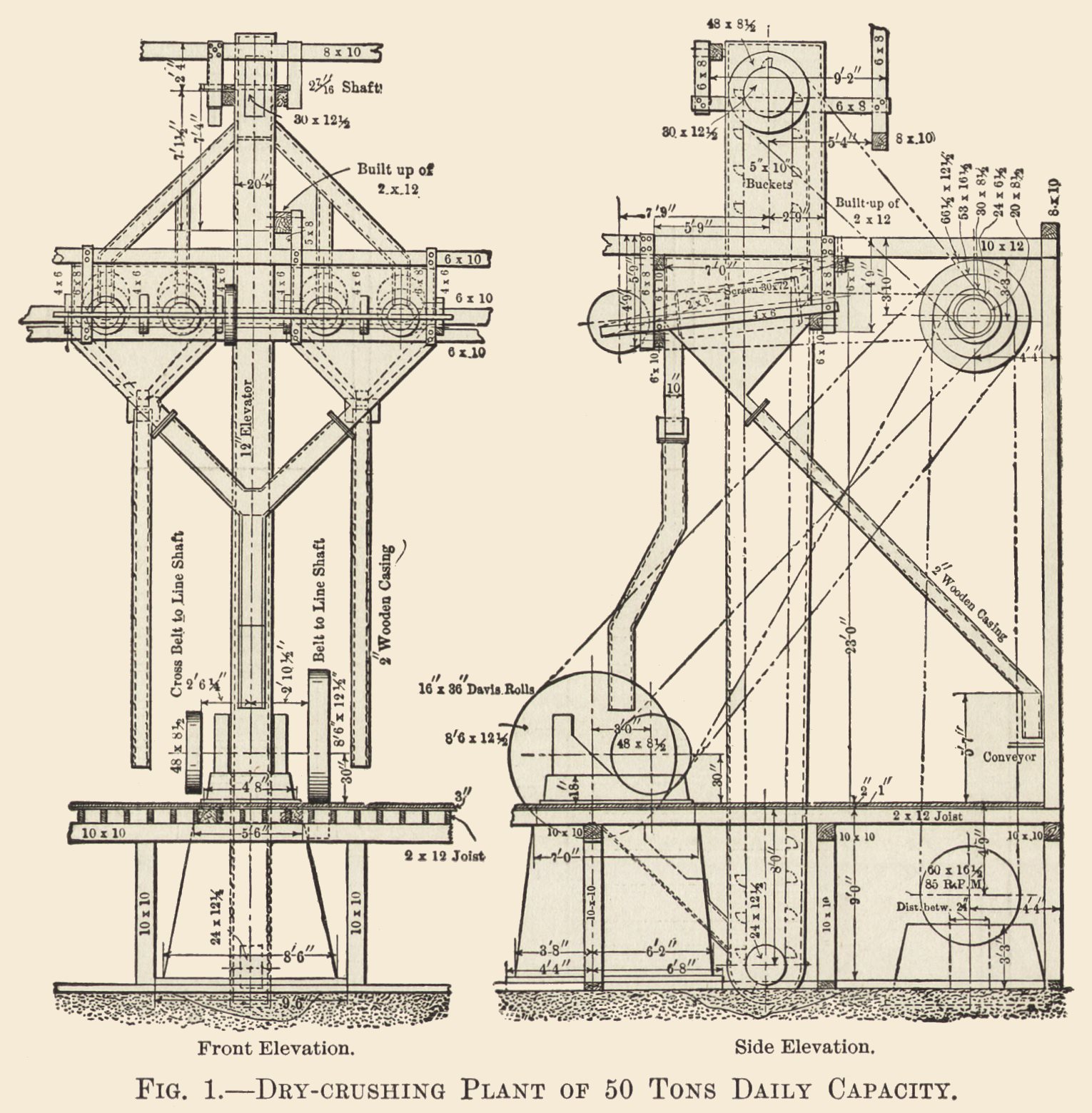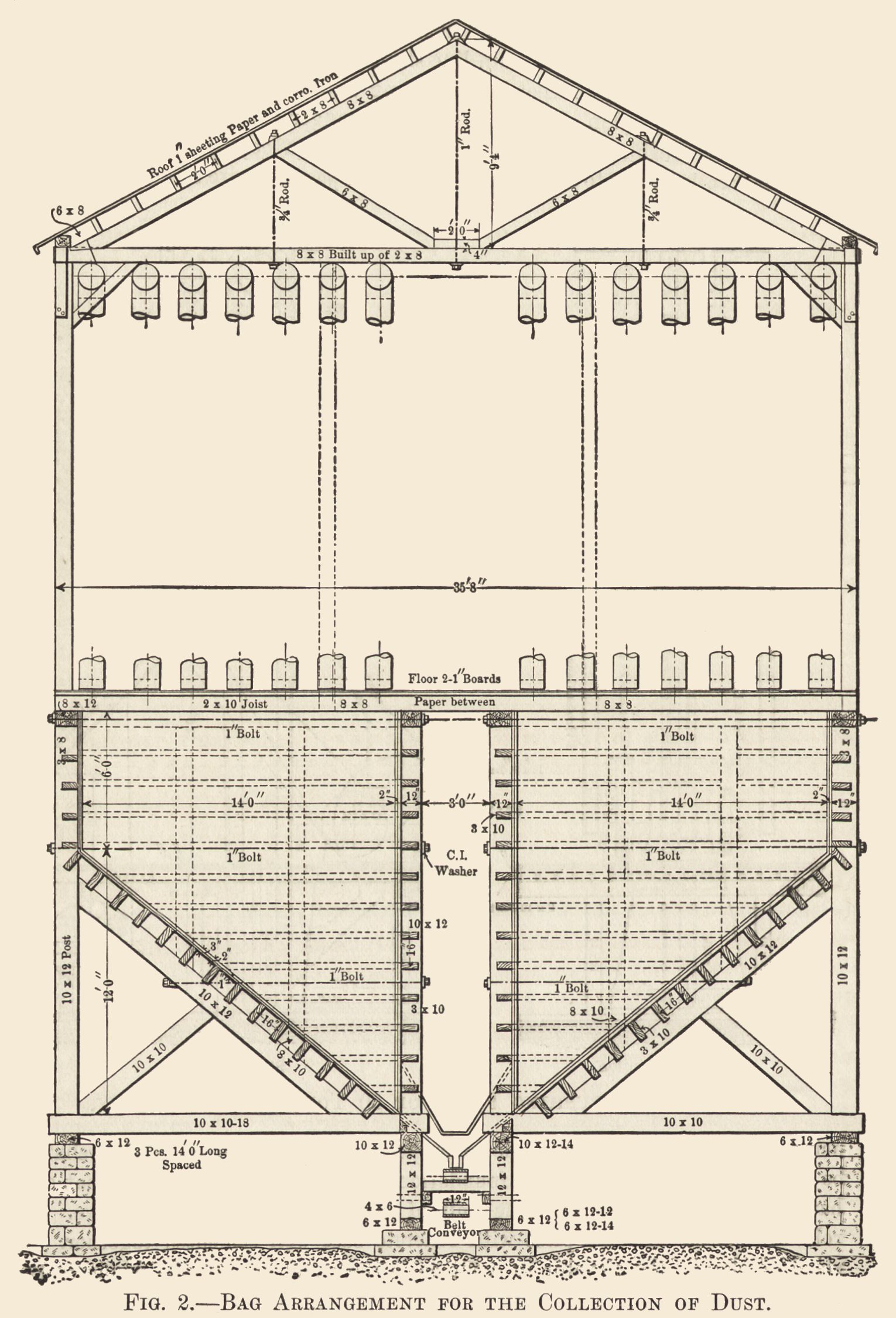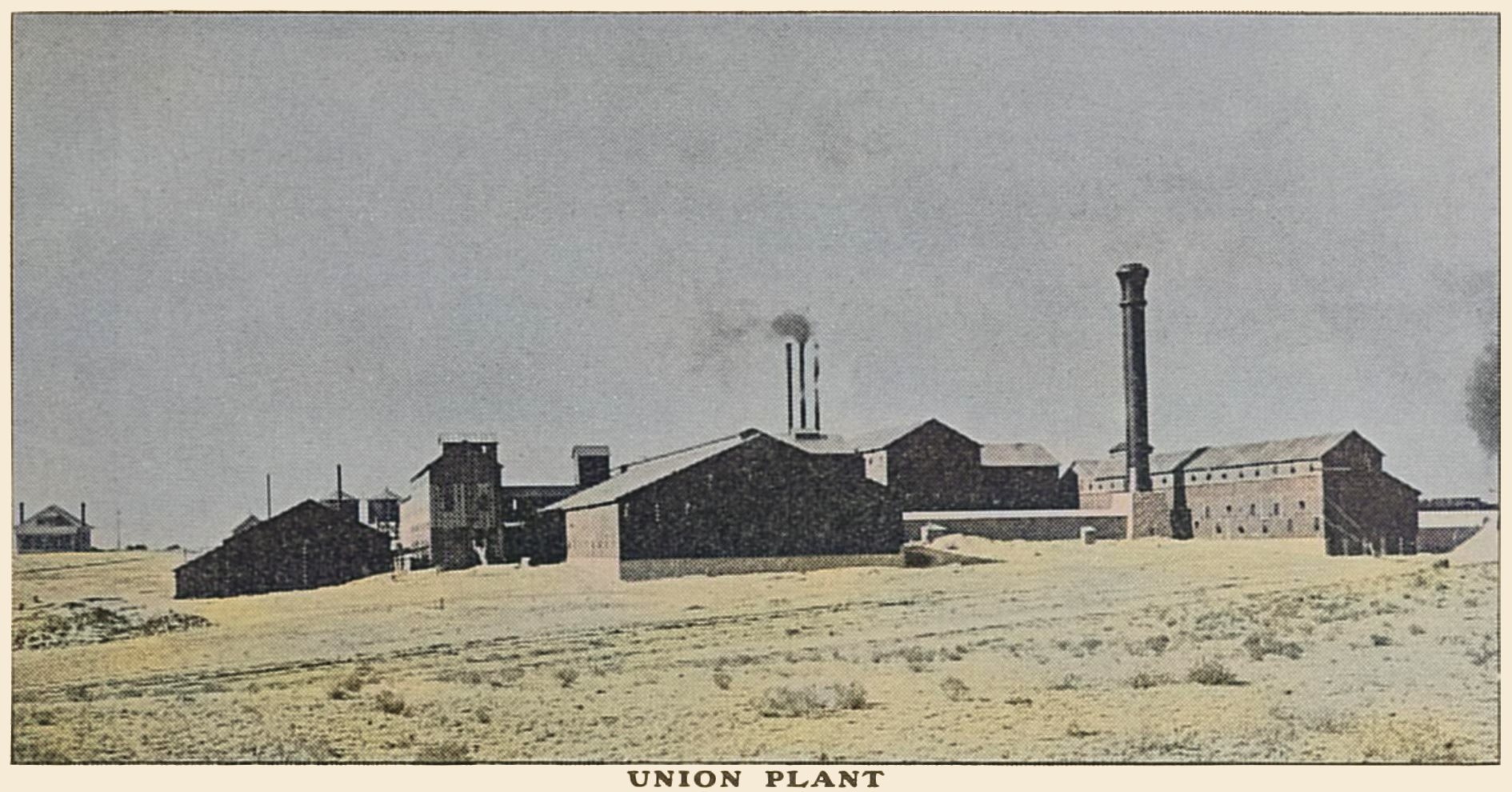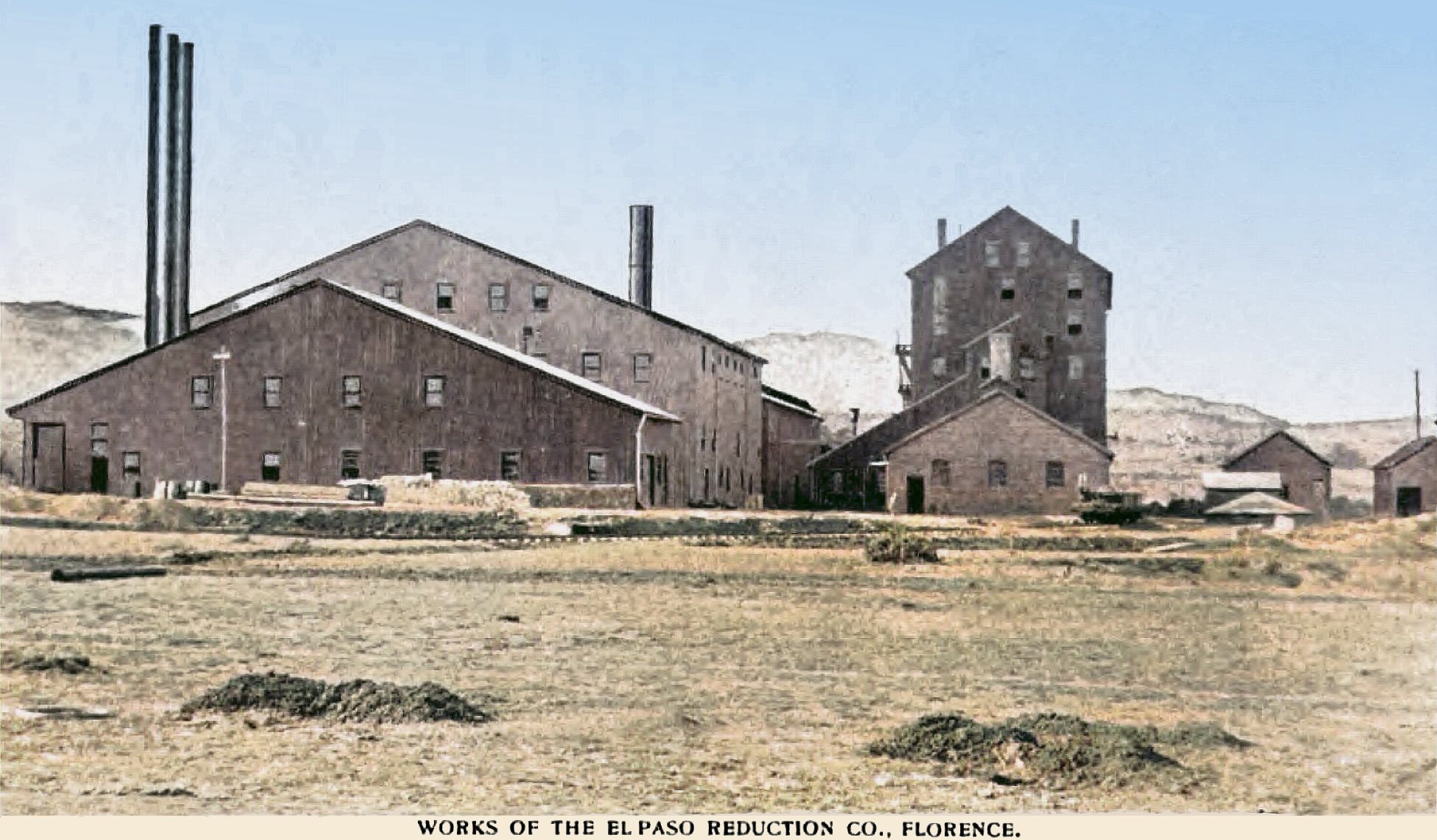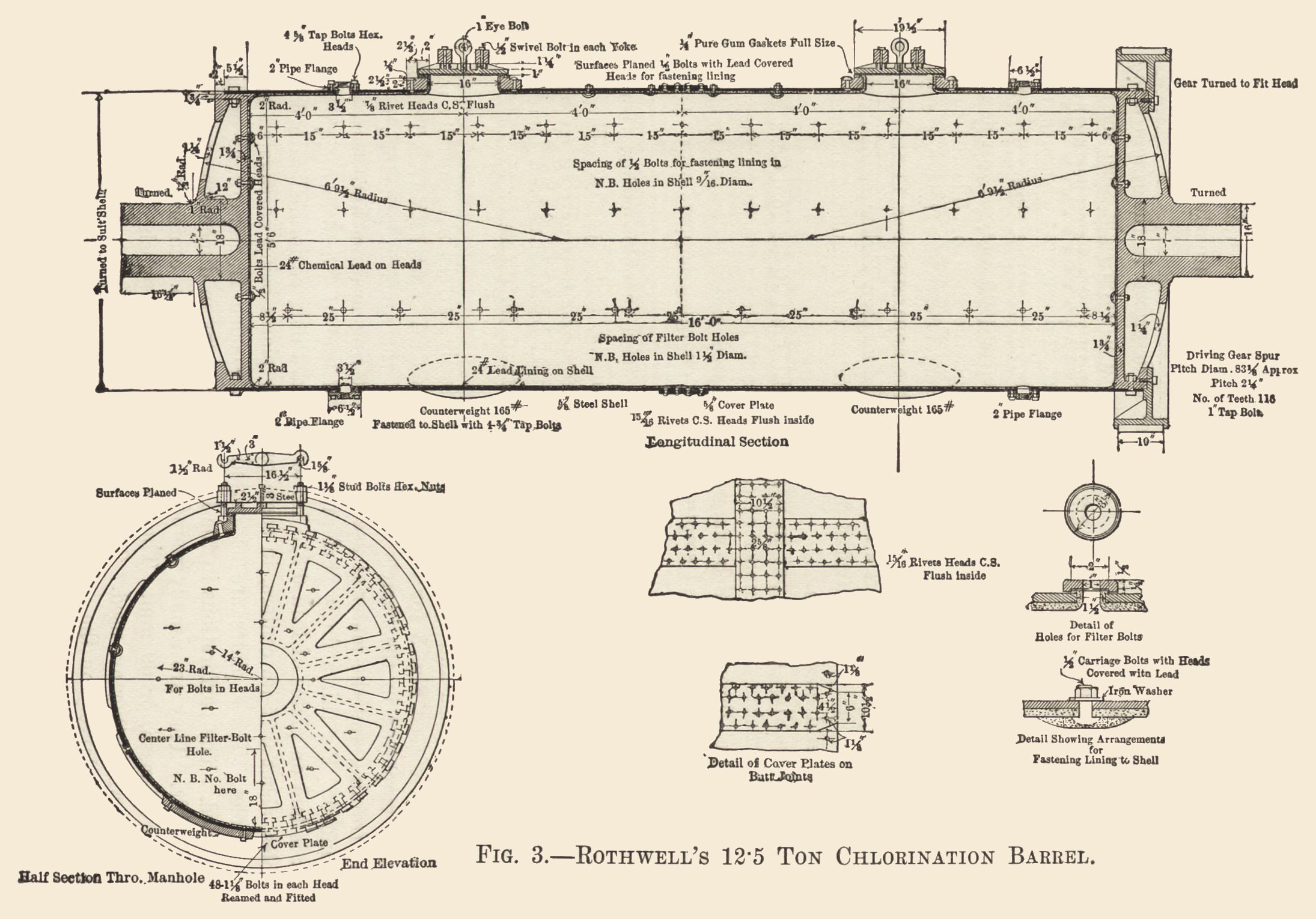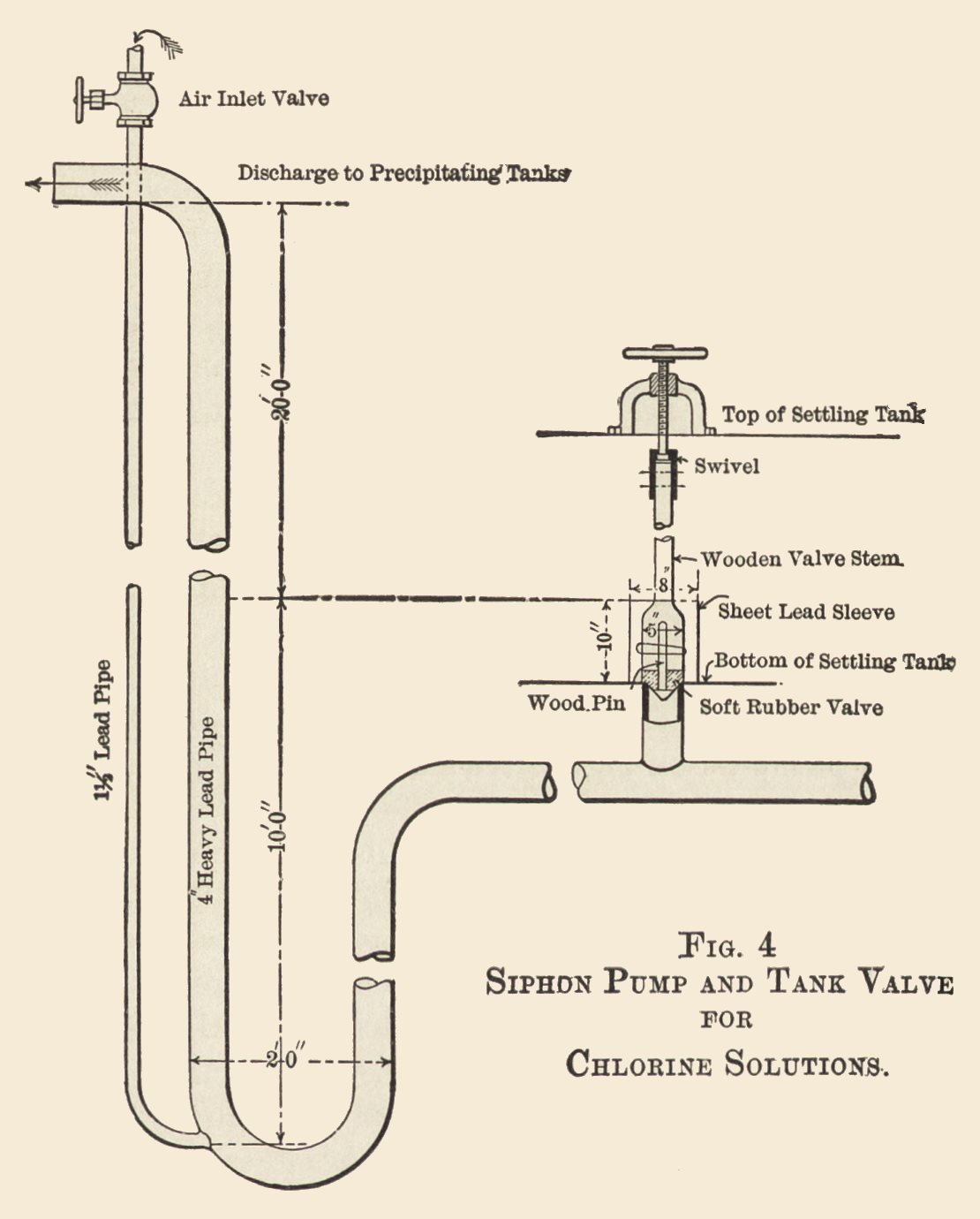-> HathiTrust Digital Library Site; Link to First main text page of article.
Source had no pics, only the figures, so I added pics from my collection
In THE MINERAL INDUSTRY, Vols. I. and V., I described the chlorination process as it had then been developed in large American works. The present supplementary article brings the practice to date and adds to the general literature of the subject, a description of those methods employed to increase the efficiency and economy of the chlorination process which have placed it on a firmer basis as one of the standard means for the extraction of gold from its ores.
Several large works have been built and put in operation since 1896, the tendency being to establish plants of large capacities, centrally located to treat the ore from a number of properties or from a district and thus save the individual miner or mining company the expense of erecting a costly plant, by providing for him a place at which he can market his output of all grades and receive a fair value for it.
Competitive plants are built where the district is favorable, and as a consequence the best metallurgical practice is necessary to make profits for the mining company. This paper is therefore chiefly in the line of a works to purchase and treat ores on this principle.
Sampling and Purchase of Ores.—At the custom mills treating the ores of the Cripple Creek district, Colorado, the ore is purchased from the miner on a basis of treatment charge which varies according to the assay value of the ore, paying $20 an ounce for all gold, and on the basis of New York quotations for all silver over 3 oz. per ton. The schedule of rates varies from time to time, but the following was in force at the end of 1900, these charges being for ore delivered at the works:
| Tenor in Gold. | Charge Per Ton. |
| Between 0.75 oz. and less | $5.50 |
| Between 0.75 oz. and less 1 oz. | 6.50 |
| Between 1 oz. and less 1.25 oz. | 7.25 |
| Between 1.25 oz. and less 1.5 oz. | 8.00 |
| Between 1.5 oz. and less 2 oz. | 8.50 |
| Between 2 oz. and less 3 oz. | 9.00 |
| Between 3 oz. and less | 9.50 |
In the last custom mill which I designed, erected and put in operation, the sampling works received the ore direct from the railroad cars in which it was shipped from the mine. These cars were stored on a track above the sampling department, and when a certain lot was ready to be sampled the cars were run by gravity to a double set of track scales, and each car weighed, unloaded and then weighed light, thus giving an exact net weight. The beams of the scales were self-registering so that mistakes in weight were practically impossible.
The ore as unloaded from the car, passed over a grizzly with 1-in. spaces, and the oversize went direct to a 10x20-in. Blake breaker, then to a set of 16x36-in. belt driven, crushing rolls running at a speed of 60 R.P.M. and set about 0.25 in. apart.
These reduced it to a product of which the largest pieces did not exceed a cube of 0.75-in. edge. From the rolls, the ore was elevated to a large Vezin automatic sampler, cutting twice in a revolution and making 48 R.P.M., or cuts per minute, which gave a sample consisting of one-quarter of the whole.
This portion then passed through a revolving cylinder 24-in. diameter and 48 in. long, set at an inclination of 10 in. and revolving 30 R.P.M., the interior having a series of baffle plates that mixed the sample thoroughly and delivered it to a second and smaller Vezin sampler which cut out one-quarter of the first sample, thus delivering an amount equal to 6.25% of the whole lot.
This accumulated in a sheet iron hopper under the last sampler until the sampling of the lot was finished when it was taken to the plate room and coned and quartered to about 400 lb. This amount was then re-crushed in small rolls, in the plate room, to about a 3-mesh product, coned and quartered to about 10 lb., and this ground in a sample grinder to about 150-mesh, and cut down to about 2 lb., which is passed through a 200-mesh screen (i.e., 40,000 holes per sq. in.) and subdivided into four samples for assay, viz., the ore seller's sample, the mill sample, the umpire sample, and one extra sample reserved for use in case of accident to the others.
The 400-lb. sample, and in some cases the whole of the 6.25% was held till the lot it represents has been settled for, so that in the event of a disagreement in the assays of the ore seller and the mill company, a resample can be made, in which case it is thoroughly mixed and again coned and quartered to the final sample.
A settlement is made only when the samples assayed come within 0.04 oz., when it is usual for the mills to split, but in case of a greater difference or some other cause, and a resample is not desired, the umpire sample is sent to a third and disinterested assayer, and should his result come between that of the ore seller and the mill, it is used as a basis of settlement. Should it be above or below both assays, the nearest is taken as a basis or a resample made.
The ore rejected by the automatic samplers passed to an elevator, then to a belt conveyor, from which it was discharged to any one of a line of storage bins, or to one of two storage beds on which it could be distributed and bedded to a uniform mixture. The different lots of ore, except those on the beds, are held separate and intact in most mills until settled for by the mill company.
From the storage bins, the ore is fed and carried automatically on a belt conveyor to a centrally located elevator that delivered it to the storage hoppers over the drying cylinders, where it was dried and passed to the fine crushing rolls and reduced to the fineness of product necessary for subsequent treatment.
Crushing Department.—For the preparation of the ore for the final treatment, rolls have not been superseded to any extent by any of the other patented pulverizers or mills that have come into existence during the last few years. The method of operating rolls is a matter of considerable difference of opinion among engineers and mill men.
For myself, I have no reason to change my opinion, expressed in the article in The Mineral Industry, Vol. V., viz., that the most economical roll is the low-speed machine. The present tendency is to make the machine very much heavier, stronger and more substantial in every way and to support it on a solid foundation. The unit system of crushing machinery is also a new feature in recent work, at the same time maintaining the gradual reduction system, as I noted in The Mineral Industry, Vol. V. The system is applicable to the larger capacities of 100 tons per day and over.
The arrangement of the units permits of any one being stopped for repair without interfering in any way with the operation of the others. Each unit comprises a set of rolls, elevator and sizing screens, all driven from a countershaft, which is driven from the main line shaft through a friction clutch or other arrangement permitting independent stopping and starting.
The elevation and plan, Fig. 1, shows the arrangement of a single unit with a capacity for crushing 50 tons in 24 hours from a coarse product of about 3-mesh or 0.25-in. cubes to a finished product that passes a wire screen of 12-mesh, using No. 19 B.W.G. wire.
The arrangement permits the main line shaft to be kept low down on substantial foundations, and short counter shafts that alone have to be kept in line with the unit of machinery they have to drive. The rolls are placed on stone piers with concrete base well cemented together. Instead of placing the elevator in a pit as is the usual custom the whole is kept above the surface of the ground, which admits of plenty of light and room for the close supervision of the machinery.
Dust Collectors.—The dust, the usual bugbear and source of loss in all dry crushing mills, is collected in several ways at the different mills, the bag-room in some of its forms being the fundamental principle. In some mills the collected dust is not treated at all, but shipped to a smelter where it is briquetted and smelted, while at other mills it is mixed with the finished pulp and passed with it through the treatment.
Fig. 2 is an arrangement used in a recent mill in which the dust is exhausted from the rolls, elevators and screen casings, by a large exhaust fan and blown into a series of cotton bags located above the pulp ore storage bins, the arrangement of which permits of the cleaning of any line of bags without interfering with the others, thus affording a continuous operation of the collecting system.
A machine largely used in flour mills is now being used in some of the new mills, in which a number of small bags are carried radially on a horizontal cylinder and arranged so as to collect the dust blown into it, discharging it automatically to a screw conveyor which in turn carries it to the main pulp elevator or chute leading to the storage bins.
Systems of hopper-bottomed storage bins in flues are also used at some mills, into which the dust is blown and settled. These, however, involve labor to empty, require attention, besides giving the dust in quantity at a single time which causes difficulties in the after treatment.
It is my belief that the best method is to mix the dust with the pulp continuously, treating the mixture in the usual manner. The object of some of the mills in separating and shipping the dust is to get over the difficulty of treating it separately, as well as to remove it, its absence tending to give a better leaching product, and in consequence, a greater capacity to the plant.
Roasting.—For the roasting of the crushed pulp before chlorination the mechanical rabbled hearth furnaces are used almost entirely. Revolving cylinder furnaces of the Oxland, Howell, Brückner and Argall types are not used to any extent in the works recently constructed, the objection to this style of furnace being the enormous dust separation and consequent difficulty in treating it.
None of the shaft furnaces of the Richard type has been installed in America, although it is reported to give excellent results in Australia, Queensland and West Australia. The hearth furnaces principally used in America are the Pearce, Ropp, Brown, Holthoff-Wethey and Jackling, the last two being recent additions to the field.
It has been the practice in treating Cripple Creek ores to arrange the mixture from the different mines so that the sulphur content will be close to 1.5% in order to get a maximum capacity to the furnace. This sulphur has to be reduced practically to zero in order to get the best extraction.
The sulphur in the roasted ore is determined in both the soluble and the insoluble states—the soluble being the sulphur in the sulphates soluble in hot water, and the insoluble the sulphur in sulphides or other forms insoluble in hot water. When a furnace is in good working condition and the pulp uniform in its sulphur content, the sulphur left in the roasted ore should not exceed 0.1%, of which for the best work the insoluble should not exceed 0.03%.
For the roasting of Cripple Creek ores, coal and oil (residuum) together are most generally used. The coal in the first fire-boxes or colder portion of the hearth, and the oil for the finish. The amount of fuel used in the different styles of furnaces varies slightly, a fair average consumption being from 90 to 100 lb. of coal, and from 14 to 18 gal. of oil per ton of ore roasted. The coal used is the semi-bituminous variety of the Colorado coal fields and costs for run of mine from $1.65 to $2.25 per ton delivered at the works. The oil is from the refineries at Florence, Colo., and costs from 75c. to $1.10 per bbl. of 42 gal.
Producer gas plants are being installed at some of the mills, but have not been in operation long enough to give reliable figures on which to base a difference of cost. Where it has been used the results are reported to be satisfactory and favorable.
The temperatures at which the roasting is done vary from the cold ore, to about 700 °F. at the first fire-box, one-third the distance on the hearth, and from this it increases to 1,100 °F. at two-thirds, the finishing heat being between 1,500 and 1,600°F.
The usual time required to pass the ore through the furnace varies from 3.5 to 5 hours, depending on the amount fed in. The gold losses by volatilization that is so much feared and discussed by metallurgists not familiar with recent practice is practically nil in the Cripple Creek telluride ores, all losses being mechanical.
The ore after being roasted is automatically cooled, which does away with the large area formerly required on which to spread the hot pulp; the labor cost to handle and spread it is also abolished. A number of arrangements have been devised for the cooling.
In some cases the return mechanism of the straight line hearth furnaces is used to move the pulp back along a hearth of light sheet iron open to the air, located either above or below the roasting hearth, as the construction of each furnace permits. This method has proven satisfactory, but involves the use of double rabble arms, which are heated in the roasting hearths and drawn through the hot pulp.
A form of cooling hearth which I designed has an annular sheet iron hearth arranged with suitable expansion joints, on which the hot pulp is distributed and plowed around, being turned over eight times in a revolution, and uniformly pushed ahead by the rabble plates operated from a central hub, on a pivot, to which the driving mechanism is attached. Three of these are now in operation at the mill of the Union Gold Extraction Co., at Florence, Colo., and cool the roasted ores from 6 forty-foot Pearce turret furnaces.
In estimating the area required to cool ore on a hearth, it has been found that an area of 6 sq. ft. of hearth surface is ample for 1 ton in 24 hours, the ore being delivered to it at a temperature of about 800 °F. and leaving it at about 100 °F.
Hearths with a water jacket have been used in several places, but no material advantage seems to be gained thereby. They are more expensive to construct, there is danger of leaking, and they require water, which has to be pumped back and cooled, unless a constant water supply is available and the water allowed to waste.
At the cyanide plant at Cyanide, Argall's patent revolving cylinder cooler is used. This is a multi-tubular cylinder revolving on tires, and arranged for the water cooling of the tubes, through which the hot ore is passed.
At the Colorado & Philadelphia Reduction Co. plant, the cooler consists of a sheet iron tower, divided in the interior with a series of sheet iron shelves, over which the hot ore passes in a thin sheet, while cold air is forced through the interstitial spaces around the shelves and carries off the heat. This apparatus has been in operation for a number of years and is apparently satisfactory. Its first cost of installation is quite large.
A water-jacketed cooler invented by me*1 is described in the Engineering and Mining Journal, July 29, 1899. It consists of a water-tight steel shell of any shape to suit conditions, with a series of tubes in it, the same as the flues of a vertical boiler; above the tubes a storage hopper, and below a mechanical arrangement like an ore feeder.
In operation the hot ore settles slowly through the tubes, the feeder arrangement being set to take the pulp away as fast as it comes from the furnace. Water is circulated through the shell outside the tubes and removes the heat. This device has proved very effective. It is not expensive and occupies very little room.
In one case the apparatus was 11 ft. high, with a base 6-ft. square, and had a capacity of 30 tons per 24 hours. No dust was made and the pulp was delivered dry. The water was circulated through tanks and cooled and used again.
Another cooling device put in use at the El Paso Reduction Co.'s works at Florence*2 consists of a number of cars of about 1-ton capacity, arranged with coils of pipe, through which water is circulated and the heat extracted, the cars then being elevated and emptied into the charging hoppers over the chlorinating barrels.
Chlorination.—In the matter of apparatus used in chlorination, there have been no changes, except in general increase in size and capacity. The roasted ore is weighed and placed in the charging hoppers, thus getting an accurate weight treated. The capacity of the chlorination barrels has been increased to as high as 18 tons per charge, in barrels 6 ft. 6 in. diameter by 15 ft. long revolved on two encircling tires.
I have designed and operated very satisfactorily barrels of a capacity of 12.5 tons of ore (see Fig. 3 for dimensions and general construction). The barrel filters employed in the barrels have remained the same in principle, although the framing and the material used for the filtering medium have been slightly changed.
For this a finely perforated sheet of lead of 4 or 6 lb. weight per sq. ft. is laid on plates of lead 0.375 in. to 0.75 in. thick, perforated with 0.375-in. holes, about 0.75-in. centers, in some cases the plates being corrugated between the holes. These plates are supported on a wooden framework as originally planned.
The perforations in the lighter sheet vary in dimension at the different mills. They are usually round and about 0.375-in. centers, and nominally about 20-mesh, or 69 mm. These sheets are usually punched by hand at the mill at which they are used. The life of the sheets varies from 6 to 60 charges, depending largely on the care with which they are put in and the character of the sheet lead used.
For this purpose "chemical sheet lead" alone should be employed. The heavy plates will last for an indefinite length of time unless the wood framework supporting them gives way. The wooden frame has a life of about three months' constant usage, after which it is so weakened that it is advisable to renew it.
The frames employed to hold the lead in place wear out rapidly, often having to be renewed every two or three weeks. In the 12.5-ton barrel, the filter has an area of 4x16 ft. The full charge of ore lies to a depth of 38 in. on the filter, and can be leached when everything is in good condition in from 75 to 90 minutes. The average time over a month's run or more is about 150 minutes, the water pressure used varying from 10 to 40 lb. per sq. in.
The gold solution from the barrels passes first to a small tank containing a gravel filter which removes any sand that may have passed the barrel filter; from this the solution flows to the settling tanks.
At the present time I build the settling tanks of large capacity, having enough of them so that at least eight hours shall elapse from the time one tank is filled until it is required again. The tanks are shallow in order to give a large area and promote rapid settling. From these tanks the solution goes direct to the precipitating tanks and in order not to get any fine slimes from them, the solution is drawn from a level 10 in. above the bottom of the tank.
The solutions are transferred from the settling tanks to the precipitating tanks by means of an inverted siphon after the principle of the Pohlé air-lift pumps, using air under pressure to force it up the outlet pipe. Fig. 4 gives a plan of this apparatus, which for the elevating of solutions is much superior to the Montejus system employed in some works.
The arrangement is similar to that which was suggested by the late C. A. Stetefeldt, in an article in the Engineering and Mining Journal, December 28, 1889, a description of which did not come to my notice until quite recently.
The siphon is connected with a line of pipe along the bottom of the settling tanks, and is placed so that its lowest part is at a point one-half the height to which the solutions have to be raised. Thus if it be necessary to lift the solution an average of 25 ft. the lower part of the invert would require to be 12.5 ft. below this point in order to give satisfactory results. Two valves only are required, one in the bottom of the settling tank to let the solution into the siphon, and one—the air valve—to admit the air for the required pressure. The solution valve is of rubber on a long wooden or lead covered stem and is operated from the top of the tank. The air valve is located at a point close to the discharge of the siphon and above any possible contact with the solution.
It will be seen, therefore, that there are no working parts to wear, and when the siphon is properly placed, there is no difficulty in starting it. For chlorine solutions, heavy lead pipe is used; a 4-in. pipe with a 1-5-in. air inlet using air at 15 lb. pressure has been found to lift 90 tons of solution a height of 18 ft. in three hours.
Precipitation.—Each precipitating tank is built of a capacity equal to that of a settling tank and is arranged with a sloping bottom for the easy removal of the precipitate; it also has perforated gas pipes to introduce the hydrogen sulphide gas which is used as a precipitant.
This gas is now used alone, the use of sulphurous acid gas as an aid having been discontinued in most mills. In some mills the resultant solution from the hydrogen sulphide generator is used to assist the precipitation and to reduce the amount of hydrogen sulphide gas required.
Charcoal as a precipitant is used in a few mills. It is found to be very satisfactory, giving a much higher grade of gold than other precipitants, the fineness of a bar being seldom below 995. The apparatus necessary for charcoal precipitation and for the burning of the charcoal is much more elaborate than that required for other methods and requires close attention.
All solutions are heated to a temperature of about 120 °F. to drive off the excess of chlorine and to precipitate the lime, the whole is then filtered through sand filters before being sent to the charcoal vats or drums. The amount of solution carrying a certain metallic gold content only is allowed to flow through a vat.
The capacity of the quantity of gold that a certain amount of charcoal will collect having been determined, the vats are then emptied into large shallow iron pans, built in a brick furnace and open to the air, where the whole is dried and reduced slowly to ash, which is then screened and fused to bullion.
Various filter presses are used for the collection of the gold sulphides from the precipitating tanks, those with the iron frame and distance frames being most general; the life of a set of iron plates under ordinary conditions is between 6,500 and 7,000 tons of ore treated. Wooden plates and frames have been used, the wood having been previously boiled in a pan of liquid paraffine until thoroughly warmed and coated.
The life of these plates has not been determined as yet, but from what is already known, it will be much greater than that of iron. They are much to be preferred to the iron plates for solutions carrying copper, and are much lighter and more easily handled. It is not, however, advisable to use them with pressures exceeding 40 lb. per sq. in., as owing to their construction they are liable to leak. However, it is seldom that pressures exceeding 25 lb. per sq. in. are required, and then only when air drying the sulphides.
Sulphide Roasting and Melting.—The sulphide roasting furnaces have not been materially changed from that described in The Mineral Industry, Vol. V., except that the muffles at some mills are made of fire clay, while at others they are of cast-iron sections to facilitate handling, the removable parts being those subjected to the most wear. A separate dust chamber is now attached to the muffle for the collection of any dust that may be carried off during the roasting operation, instead of allowing it to mix with the dust from the fire as formerly.
The mills treating Cripple Creek ores use oil-burning crucible furnaces for the reduction of the roasted gold slimes to bullion. In furnaces of this type, the oil residuum, similar to that used for the ore roasting, is thrown by a jet of steam or compressed air against a network of fire brick under the crucible, from an ordinary oil burner; the oil ignites and the rising flame circulates around the crucible; the time required to fuse a charge varies from 45 to 60 minutes when starting with a hot furnace.
Concentration.—A feature of the treatment of Cripple Creek gold ores, and one peculiar to this section only, is the use of tables or other concentrating devices for the saving of values after the soluble have been extracted. The gold in the ores is to some extent coarse and is also in the form of globular particles from the tellurides during the roasting; a condition which requires a lengthened time for the solution of the gold. Concentration, however, overcomes this difficulty as it removes the gold in this condition very easily and possesses the additional advantage of saving any unroasted iron sulphide or iron sulphide that has been sintered by too high a roasting heat.
In operation, the tailings from the chlorinating tanks are discharged direct to a series of settling tanks, or to a separate tank and then elevated to settling tanks, or direct to feed launders of the concentrating tables. The pulp is sent first to a series of roughing tables, where a preliminary concentration takes place, and this concentrate, from four double-deck or six single-deck tables, is elevated to one finishing table for final concentration.
The degree of concentration varies with the ore treated, but is seldom less than 50 tons of tailings to one of concentrates, and is often as high as 120 to 1. The saving made on the tables will average throughout 50% of the contained value. The concentrate thus made is shipped and sold to the smelter. The cost of concentration is comparatively light, as the pulp is already prepared for it, the only items of cost being labor, power, water and repairs.
For labor, three men a shift can easily take care of 20 double-deck tables and accompanying machinery and handle 300 tons per day, or 150 tons per shift of 10 hours. The power required is safely estimated at 0.5 H.P. per table, and the supply of necessary water is from 500 to 700 gal. per ton of material concentrated. Where water has to be pumped and economized, a system of settling tanks is arranged by which about one-third of the water used can be saved.
Metallurgical Work.—In all the modern plants, the laboratory forms a very prominent part and closest attention is given to all metallurgical operations. Complete analyses of all the ores to be treated are made, as well as partial analyses of every lot of ore purchased, and the best methods of mixing are determined with reference to the mechanical and chemical operations.
Careful checks are made in the different departments to ascertain the losses of each operation and to bring them to a minimum, as well as to keep an accurate check on the bullion that should be produced. Chloride of lime (bleaching powder) and sulphuric acid are still used as the chlorine-producing chemicals for barrel chlorination, although in the vat process, liquid chlorine has found a foothold and much may be expected of it.
At present, however, its price has been the chief factor against its greater use, and except in isolated places where transposition is high, it has been found cheaper to use the more bulky material. It is reasonable to suppose that, before long its cost will be very materially reduced, and means will be found by which the liquid chlorine can be shipped in more convenient and less expensive packages.
On Cripple Creek ores, the usual chlorine-generating, chemical charge for one ton of roasted ore is from 12 to 15 lb. of chloride of lime, averaging from 34 to 36% available chlorine, and 24 to 30 lb. of sulphuric acid 66°B. The excess of acid necessary over that theoretically required to liberate the chlorine from the chloride of lime is due to other soluble compounds in the ore, which consume a certain amount of acid before it completely satisfies the chloride of lime; furthermore an acid solution is required in order to get the best extraction.
It is always necessary at the end of the chlorination to have an excess of gas. In some mills this is allowed to escape before starting the leaching; the best practice, however, is to leave it in the barrel where the wash water will take it up, thus getting the advantage of the solution in the chlorination.
The gold hearing solutions are assayed to determine their value; the method generally followed is to take from 1 to 10 assay tons of the solution, or its equivalent in cubic centimeters, pass hydrogen sulphide through it until everything it contains that will be precipitated by the gas has been thrown down, and then filter the whole through double or triple filter papers.
The paper containing the precipitate is calcined in a fire clay crucible of 10 g. capacity and the ash mixed with a small amount of litharge and soda, enough to reduce a lead button of about 5 g., which is cupelled and the gold weighed in the usual way. By this method it is possible to make a very rapid determination of the value of a solution, the time required for the operation not exceeding one hour when the assay furnace is available.
It is difficult to get at the cost of treating ores at the different Cripple Creek mills, but from my experience the following figures, covering the average of several mills, give a close estimate:
| Per Ton | |
| Labor, including office force salaries. | $1.34 |
| Chemicals and supplies. | 0.72 |
| Fuel for roasting and power. | 0.70 |
| Removal and repairs. | 0.45 |
| Miscellaneous expenses. | 0.32 |
| Total per ton | $3.53 |
* Notes:
![Click for larger view, more info Union Mill Gold Ore Reduction [Mill Near Florence, Colorado]](/04library/postcards/p-03346_union-mill-gold-ore-reduction_crpd_enhanced-colored_scld18px.jpg)
